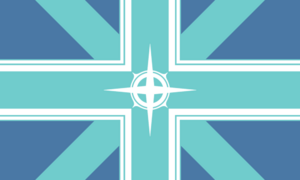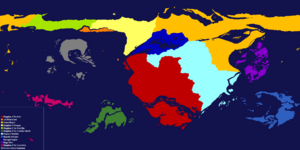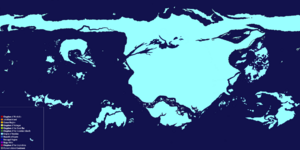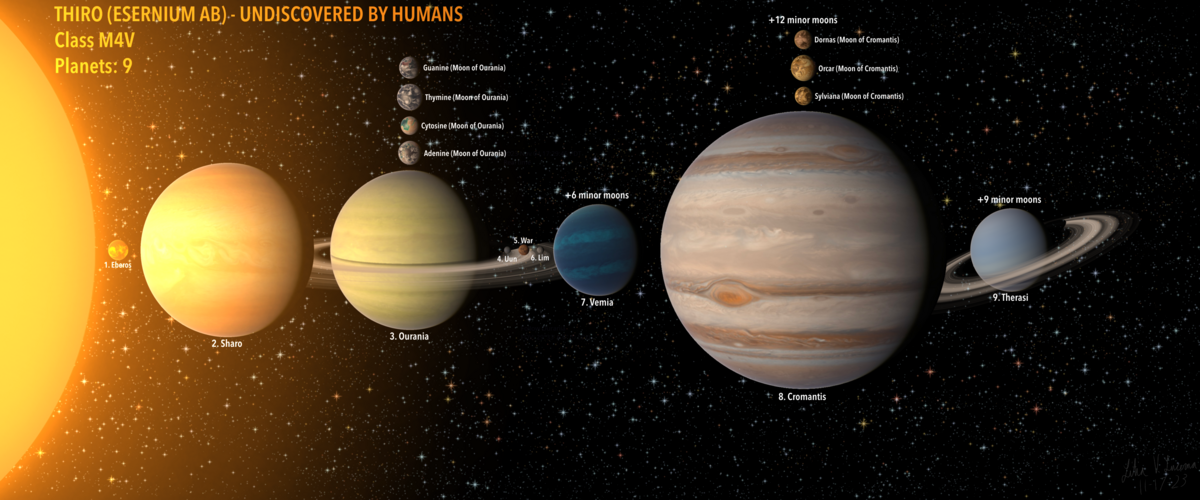Kingdom of Kerolon
Kingdom of Kerolon Nairahak gn Kerolon (Golagat) | |
|---|---|
|
Motto:
| |
|
Anthem: Uingffhian Glory | |
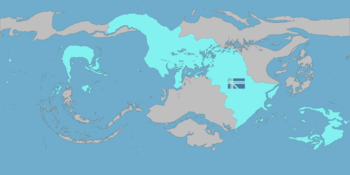 Diagram of Kerolon's territorial claims on Uingffh | |
 The Ingffhaestian System, the home system of Kerolon | |
| Capital | Korroway, Uingffh, Ingffhaestian System |
| Largest city | Chance, Lavoie, Thrawn System |
| Official languages | Golagat |
| Religion | Secular (de jure) |
| Demonym(s) | Kerolonian |
| Government |
|
• Ring | Mesmo Kerilim Kerolon (1905-) |
• King | Novus Marune Kerolon |
• Queen | Urion Sima Kerolon |
• Prime Minister | Perle von Nurnberg |
• Master of the Court | Ramya Karma |
| Legislature | Kerolonposium |
| Establishment | November 14, 999 |
| Population | |
• 2033 estimate | 648.12 billion |
| GDP (nominal) | 2033 estimate |
• Total | 87.379538 quadrillion imperial sters ($87.379538 quadrillion USD) |
• Per capita | 134,820 imperial sters |
| Currency | Imperial sters |
| Today part of | Federative Planets of Polyingffhaestia |
The Kingdom of Kerolon, sometimes colloquially referred to as the Empire of Kerolon or simply Kerolon, was an interstellar superpower that, at its greatest territorial extent, officially controlled a total of 37 star systems across the Orion-Cygnus Arm of the Milky Way alongside countless other incorporated stellar territories. Its capital was the city of Korroway on the moon Uingffh in the Ingffhaestian System, and its dominant species were Uingffh's three native sentient species: the tabulons, lordions, and mortei.
As the longest-lasting nation known to Uingffhian records, Kerolon had a long and significantly complex history. The Kingdom formed on the moon Uingffh on November 14, 999 when a trio of tabulons named Otho, Gauss, and Nero Kerolon united the region's various small warring kingdoms under their reign in the Unification War. Seating themselves as the newly-formed Kerolonian Kingdom's royal family, Otho, Gauss, and Nero steadily developed their nation's economy and society. Within two centuries, Kerolon had grown into a prosperous kingdom with a thriving economy and a rich culture. By the rise of the 13th Century, the Kingdom of Kerolon had begun to develop imperialist ideologies and began a program of expansionism across Uingffh, which proved highly successful; by the 1500s, Kerolon had gained control of all parts of Uingffh. Shortly after, however, indigenous rights movements, internal disputes, and other factors caused parts of this "Kerolonian Empire" to begin collapsing; most notably, its northeastern territories seceded into the Unified States of Osuwa over excessive taxation while its western territories seceded into the Great Imperial Hegemony of Morbidia over discrimination against Lordions. Kerolon, however, remained a major power in Uingffhian geopolitics and retained all of its other territories along with the title of largest Uingffhian country.
Though conflicts erupted early on, Kerolon relatively quickly came to exercise peaceful relations with Morbidia and Osuwa, with the three becoming Uingffh's three dominant powers; within Kerolon, reformist politicians transformed Kerolon into a highly progressive, egalitarian, and advanced parliamentary nation over the course of a few centuries. Eventually, beginning in around 1700, Kerolon as well as its two Uingffhian neighbors, motivated by the discovery of ancient ruins supporting the existence of an ancient alien race responsible for seeding all known life, developed spacefaring capabilities and evolved into interstellar nations, discovering and colonizing nearby star systems; Kerolon in particular desired to colonize space to increase its economic prosperity while also discovering and learning more about the universe. In the process, they discovered numerous other alien races seeded by the same ancient alien race; though conflicts occurred on occasion, Kerolon tended to welcome these civilizations into its society and ensured their equal treatment under Kerolonian law. Though Kerolon was lauded for these egalitarian efforts, some non-Ingffhaestians still criticized the Kingdom for being too expansionist and militaristic, with a few particularly critical individuals viewing Kerolon as nothing more than a space empire using social justice as a thin veil to hide its colonialist tendencies.
Beginning in the early 21st Century, tensions between the Morbidian Hegemony and the USO began to rise as their cold war began transforming into an actual interstellar war, with the two nations competing to amass as much interstellar influence and military power as possible. During this time period, Kerolon tended to act as a mediator between the two powers and attempted to foster peace, to mixed results. At the same, opposition to Kerolonian colonial expansion began growing, most notably in the form of armed rebellions.
TBA
History
Important note: Terms for government-related organizations such as "Council of Nations", "House of Affluence", or "Social Democrats" are translated from Golagat, the native language of the tabulon civilization, to English.
Formation, War of Unity, and Development (pre-999-1200)
Prior to Kerolon's formation, the region of Ulstonia it would come to inhabit (also called Kerolon) was home to several smaller kingdoms and warlord states locked in conflict. During the decade of the 980s, a trio of nobles - Otho rei Oronius, Gauss rei Keyman, and Nero rei Hadrian - began campaigning for a unification of the Kerolon region into a single kingdom, having lost many of their family members to wars between the micro-kingdoms. Over the next few years, the trio amassed numerous like-minded supporters who had also suffered under the kingdoms' many wars and armed conflicts; many of these supporters were soldiers and militiamen growing tired of fighting needless, protracted wars in the name of petty kingdoms.
By the end of the decade, support for Kerolonian unification - particularly from military-involved individuals - had grown substantially, with the trio of nobles enjoying the support of a body of soldiers rivaling the size of a large army. In 999, Otho, Gauss, and Nero finally put their plan into action and mounted an invasion of the Kerolonian micro-kingdoms using their many soldier supporters, beginning the War of Unity. Though the kingdoms had the advantage of combined territory, their refusal to work together led to their swift ends, which sometimes occurred at the hands of their own soldiers. In addition, many smaller villages welcomed the unity trio's occupation, themselves dissatisfied with the divided state of the region.
By November 14 of that year, the three nobles had ousted the rulers of all of the Kerolonian mini-kingdoms and united them under a new nation: the Kingdom of Kerolon. Otho, Gauss, and Nero established themselves as the monarchs of Kerolon, becoming Otho Oronius Kerolon, Gauss Keyman Kerolon, and Nero Hadrian Kerolon. Because none of the three shared a sex (Otho was female, Gauss was male, and Nero was somale), the trio was able to marry each other and become the first members of the Kerolonian Royal Family; though the marriage merely constituted a political marriage and did not involve actual romantic or sexual feelings between the three individuals, the three monarchs succeeded in effectively ruling and managing the fledgling kingdom.
To celebrate the successful formation of Kerolon, the three monarchs chose to establish a new Uingffhian timekeeping era to commemorate the unification of the region: Ascension Ring Kerolonnia, or a.r.k. for short. The Earth year 999 would be designated 0 a.r.k., with succeeding Uingffhian years being denoted by greater numbers followed by "a.r.k." at the end. As Kerolon's influence spread later in its history, the a.r.k. system would become the standardized timekeeping system for all of Uingffh. In addition, the throne of the Kerolonian monarchy would come to be referred to as the Aeonium Throne.
Residents living under the newly-established Kerolon regime welcomed this changing, lauding the political stability and newfound peace it brought. The Royal Family's success in incurring economic growth only increased public support of them. Over the next few centuries, the Kerolonian economy continued to grow as a united Kerolonian culture began to emerge; Kerolonians adopted sophisticated lifestyles that focused on the arts (painting, creative writing, music, etc.), academics, and sciences. These opulent lifestyles, however, were largely restricted to aristocratic families such as those inheriting the nobiliary particle of "rei"; servants and the poor continued to languish under the same unsatisfactory living conditions they suffered under prior to Kerolon's formation.
Keliosity, a religion that had dominated the Kerolonian micro-kingdoms prior to the War of Unity, persisted in the newly-formed Kingdom of Kerolon as its dominant religion. Keliosity's basic principles entailed the worship of Coppelius, Uingffh's parent planet, as the home of the god Kelios, also known as The All. The united Kingdom of Kerolon's version of Keliosity underwent some minor changes over the succeeding centuries to better align with Kerolon's artistic, intellectual culture; this version of Keliosity became known as Kerolonian Keliosity.
First Age of Imperium (1200-1580)
By the beginning of the 13th Century, Kerolon had grown into one of the most prosperous and influential nations on Uingffh under the rules of first monarchs Otho, Gauss, and Nero and the newly-appointed second reigning monarch, Queen Sirona Grannus Kerolon. The Kingdom, already a prominent hotspot for the arts and scientific advancements, was now becoming one of the first nations on Uingffh to industrialize; capitalism was also beginning to arise as Kerolon's dominant economic system, contributing to Kerolon's economic growth.
This economic and cultural prosperity, however, also gave rise to imperialist sentiment amongst Kerolonian natives, who desired to spread the Kingdom of Kerolon's prosperity outside of the Kerolon region (termed the "aetherland") to other parts of the moon. Some particularly nationalistic Kerolonians believed in the inherent genetic superiority of Kerolonians as a race and advocated for the subjugation and "civilization" of other peoples they viewed as primitive and savages. Ever-growing businesses and corporations, which flourished under Kerolon's nascent capitalism, viewed imperialism as an opportunity to gain access to new resources and larger markets. Devout Keliosites also supported Kerolonian imperialism, seeking to convert foreigners to Keliosity. Some Kerolonians supported imperialism simply out of a curiosity about the rest of Uingffh.
Thus, the 13th Century marked the beginning of a period of Kerolonian history known as the First Age of Imperium, which was marked by conquests of foreign lands. Kerolon began by colonizing various islands off the shore of Kerolon, such as Kirbani Island, during the first half of the 13th Century. Afterwards, Kerolon carried out the conquest of the rest of the Ulstonian supercontinent, beginning with the Osuwa region to the northeast and completing its world-conquering endeavor by the start of the 15th century. The Kerolonian Empire spent the last century of its first imperial era conquering the various island continents surrounding Ulstonia, such as Uveerius and Uopia. By 1556, Kerolon had secured control of the entirety of Uingffh.
The Kerolonian military saw noticeable development during the First Age of Imperium. In addition to funding boosts and technological improvements, the military also saw significant reorganization; most notably, the rise of esteemed conquerators - particularly skilled military commanders and explorers who spearheaded the discovery and colonization of new Uingffhian lands. Additionally, Queen Sirona and the two other monarchs who reigned during the First Age - Mesmo Martius Kerolon and Rictell Sorges Kerolon - assembled four chivalric orders - the Orders of Kerbos, Novus, Uris, and Sorellius - out of the most elite conquerators.
Infamously, Kerolon’s various conquests also severely harmed the native inhabitants of other Uingffhian regions, such as lordions, mortei, and even other tabulon peoples. As part of the colonization process. Kerolonian settlers expelled countless natives out of their rightful lands and claimed their homes as their own. In extreme cases, conquerators committed outright genocides and massacres against native peoples, which proved the case for most island civilizations Kerolon encountered.
Kerolon also affected natives and their lands in more indirect ways. Even in more tolerant colonies, natives suffered from high mortality rates due to Kerolonian settlers inadvertently importing Kerolonian diseases into both people and important food sources. Additionally, Kerolonian colonization often hurt the environment by introducing invasive Kerolonian species as well as through the use of unsustainable agricultural and manufacturing methods by Kerolonian industries.
Age of Reform (1556-1700)
The total conquest of Uingffh marked a technological and cultural peak for the Kingdom of Kerolon. The nation had made significant progress in industrialization and was well on its way towards modernizing. Meanwhile, morale for Kerolonian tabulons was at an all-time high, with the Kingdom's planetary dominance inspiring powerful nationalism and patriotism.
However, the global Kerolon Empire would quickly prove unstable and fragile. Throughout succeeding years, the nation's politicians and leaders faced - and failed to succeed in - the task of managing all of its newly-acquired colonies and their many dissatisfied, oppressed natives. Various Kerolonian territories would secede from the empire in opposition to various Kerolonian policies, simultaneously encouraging citizens within Kerolon to question Kerolonian social and political norms and push for reform within their own nation. This era would come to be known as the Age of Reform, which also marked the end of the First Age of Imperium (as Kerolon could not conquer any more territory using the technology it possessed at the time).
Osuwan Revolution and the Formation of the Unified States of Osuwa (1561-1584)
The first of Kerolon’s colonies to rebel were the colonies of Osuwa, a region of Ulstonia northeast of the Kerolonian aetherland. Prior to Osuwa’s secession, Kerolon had begun increasing taxes on a variety of goods and services consumed by Osuwans in order to fund its later conquests, to little benefit for the Osuwans themselves. When the Osuwans protested Kerolon’s exorbitant tax rates, the Empire simply enforced its taxation policies through police and military force, damaging numerous Osuwan lives and properties. Kerolon even resorted to ousting local elected leaders and seating staunch Kerolon loyalists in their place, ensuring the Osuwans’ loyalty to the Kerolonian Empire.
Eventually, Kerolon’s authoritarian policies drove Osuwans to a breaking point, leading to the beginning of the Osuwan Revolution in 1561. The revolution initially aimed to convince Kerolon to more fairly and liberally manage the Osuwa colony. But after a failed attempt at reorganizing Osuwa into a pro-Kerolon dominion in 1572, the revolutionaries’ goal shifted to forming an entirely new nation out of the Osuwan colonies. The overconfidence of the Kerolonian forces at Osuwa allowed the Osuwan rebels to fight back and eventually succeed, forming the Unified States of Osuwa on July 4, 1576. The Osuwan Revolutionary War followed, with the fledgling Osuwa and Kerolon warring until 1584, when large-scale revolts in other areas of Uingffh forced Kerolon to strike a peace treaty with the Unified States.
Korroway Riots of 1580 and the Formation of the Kerolonposium
The outbreak of the Osuwan Revolution and the adoption of democracy as Osuwa's governmental system inspired the Kerolonian populace to think more critically of the Kerolonian governmental system. Noticing and desiring the Osuwans' high political freedom, Kerolonian citizens began calling for the establishment of a more democratic system of government for the Kerolonian homeland. This led to the outbreak of numerous pro-democracy protests throughout the latter half of the 1570s.
These protests proved difficult to suppress due to their sheer size, eventually culminating in the Korroway Riots of October 16, 1580, when an estimated 12,000 democratic protesters attacked the Kerolonian palace in Korroway with the intent of removing the monarchy from power and establishing a democracy in its place. Though the protesters were ultimately driven away, they and the Kerolonian government soon attempted compromise solutions facilitated by government officials sympathetic towards the cause of democracy. Eventually, on December 25, 1580, King Rictell conceded to establish a democratically elected parliament - the Kerolonposium - and shift his role into that of a constitutional monarch.
The Kerolonposium initially adopted bicameral system consisting of a lower house (the House of the Lower) tasked with creating legislation and an upper house (the House of the Affluent) tasked with checking legislation. The House of the Affluent notably consisted of nobles loyal to the crown, allowing nobles and royals to control the passage of laws to a degree. However, the monarchy and nobility's role in parliament would gradually subside throughout succeeding centuries as Kerolon continued to democratize and reform.
Regalius' Rebellion and the Formation of the Great Imperial Hegemony of Morbidia (1578-1585)
The final major revolt during the Age of Reform was Regalius' Rebellion, which led to the formation of the Great Morbidian Hegemony out of Kerolon's Morbidian colony. The Osuwan Revolution's progression inspired many lordions, whom Kerolonian colonists had largely enslaved following the Morbidia region's annexation into Kerolon, to rise up and fight for their own rights. This began as intermittent slave and servant revolts across the Morbidia colony which slaveowners quickly put down; in response to the rebellions, the Kerolonians harshened their treatment of their lordion servants in order to prevent more revolts. However, this ultimately served to not only further strengthen lordion opposition, but also encourage the lordions to revolt in more creative ways.
The lordion revolts eventually culminated in the rise of Regalius Rilna Mortimer, one of the most radical lordions at the time, to public prominence in 1578. Taking advantage of the weakened state of Kerolonian law enforcement at the time thanks to instability wrought by the Osuwan Revolution, Regalius spread strong anti-Kerolonian, Morbidian separatist sentiment across the Morbidian region.
Initially, he attempted to change Kerolon from within by joining the Kerolonposium as part of his own Anti-Imperialist Natives’ Alliance (AINA) party; however, after Kerolon expelled the party in 1584, Regalius resorted to armed rebellion against Kerolon, seceding the Morbidia region into the Great Imperial Hegemony of Morbidia on April 27, 1584. The subsequent Morbidian Revolutionary War proved short-lived - lasting only until 1585 - but devastating, claiming the lives of hundreds of thousands of soldiers and resulting in the destruction of many properties.
The revolutionary war ultimately ended with Kerolon recognizing Morbidia’s independence as well as the Uveerius and Uopia island continents also seceding into Morbidia. The latter secession solidified Morbidia as a force of justice for not only lordions, but also any and all cultures oppressed by Kerolonian imperialism. Contrary to Osuwa, however, Morbidia would debelop an autocratic system of government as well as a total command model of economics.
Geptunia Revolution and the Wexxian Age of Freedom (1632-1650)
Another major turning point in Kerolon’s political shift was the Geptunia Revolution, which began with the ascension of Geptunia Sylandro Kerolon to the Aeonium Throne in early 1632. However, Geptunia proved to be a tyrannical and selfish ruler who pursued an overly luxurious lifestyle at the expense of the rest of Kerolon’s populace. This led to Geptunia’s swift ousting from the throne in 1633, which ended with Geptunia’s execution.
With Geptunia dead, her sister, the far more progressive Wexxia Sylandro Kerolon, became queen. Contrary to Geptunia’s reign of despotism and terror, Wexxia drastically increased the liberties of Kerolon’s people and ushered in a new era marked by social progressivism and enhanced political freedom. Queen Wexxia and her parliament legalized same-sex relationships, promoted gender equality, dismantled the racist and speciesist societal systems of imperial-era Kerolon, and drastically diverted political power from nobles (whose role Wexxia reduced to a ceremonial one) to the general populace, among other things. The populace dubbed this time period the Wexxian Age of Freedom due to the numerous social and cultural advances during Queen Wexxia’s rule.
Modernization (1650-1776)
Near the beginning of 1650, the Kerolonposium and Queen Wexxia passed an act that changed Kerolon's motto to "Education is Freedom" in order to reflect the nation's new, more progressive post-imperial society; specifically, the motto references the increased funding of the public education that occurred during the Age of Freedom, which was done in order to inform future generations on Queen Geptunia and imperial Kerolon's past mistakes and ensure they would not repeat them. This marked the beginning of Kerolon's modernization.
During this era, Kerolon and other Uingffhian nations had begun to modernize, with more advanced technologies such as electricity, wireless communication, etc. becoming more available to the average citizen. High-tech skyscrapers and cities came to accompany Kerolon's traditional buildings, palaces, and historical sites. Meanwhile, the Age of Freedom-era trend of progressivism and social equality continued; Among the reforms achieved were further protections for LGBTQ+ individuals, policies promoting racial and species equality in Kerolonian society, and improved accessibility for both disabled people and neurodivergent people. Most notably, egalitarian measures taken during the Wexxian Age of Freedom inspired the Kerolonian populace to push for more economic equality, gradually leading to Kerolon's transformation into a mixed economy, social democratic welfare state similar in nature to the Scandinavian countries on Earth; universal healthcare, public education, public transportation, and other reforms guaranteeing essential utilities paid by progressive tax rates.
Additionally, after the death of Queen Wexxia to a climate change-enhanced tropical cyclone that hit Korroway in 1699, Kerolon began to focus on minimizing its effects on the environment and relying on more eco-friendly infrastructure. Fossil fuel plants found themselves replaced by massive wind farms, geothermal power plants, experimental nuclear oower plants, and other renewable energy sources. Kerolon also aimed to decrease the environmental impact of its cities by further increasing funding for public transportation, catering to pedestrians and bicyclists, incorporating more native flora into its landscapes and architecture, and more.
Despite Kerolon's growing social progressivism, the Kingdom held on to its cultural roots and practiced its traditions in non-discriminatory ways. For instance, the four chivalric orders of Kerolon maintained their existence, but were demoted to more ceremonial roles and were often sent on charitable missions to areas negatively impacted by Kerolonian colonialism. Keliosity also remained prominent amongst the Kingdom’s citizens, though the Kerolonposium passed laws preventing the use of the religion to justify bigotry.
Early spacefaring
It was during the modern era that Kerolon began developing early spacefaring capabilities, officially beginning with the establishment of a dedicated space agency - the Kerolon Astronomical Division (KAD) - in 1720. Throughout the succeeding decades, Kerolon began building space stations around Coppelius, exploring nearby celestial bodies, and sending probes to farther reaches in the Ingffhaestian System.
It was during the early spacefaring era that Kerolon (and by extension, the Uingffhians as a whole) discovered the Ophisian civilization of Ibiridius and the Sheepilly civilization of Hevectavia. However, Kerolon and the other Uingffhian nations would not readily interact with the Ophisians and Sheepillies until the beginning of their interstellar era, when Uingffh acquired better spacefaring technology allowing them to more easily travel to and from both civilizations’ homeworlds.
Discovery of the Great Pit and the Izlondian Ruins (1776)
On November 25, 1776, Kerolonian scientists discovered the existence of extremely old, yet well-preserved ruins of a civilization whose architecture did not match that of any known civilizations. Further analysis and research of the ruins revealed their true source: an ancient intelligent civilization that had died out approximately 3 billion years ago. This civilization, named Izlondia according to its dominant species, the Drori, had once controlled all of Uingffh and possibly all of Ingffhaestia and various outlying star systems before dying out in a catastrophic accident involving wormhole technology; it was this calamity, dubbed the First Apocalix, that had rendered their vast cities trapped underground.
More importantly, significant evidence pointed to the Drori species forming the ancestors of the tabulon race. In addition to bearing a remarkably similar appearance to modern tabulons (with their only major physical difference being their lack of wing-tentacles), the Izlondians also shared a significant amount of DNA - 98.5% - with the tabulons as demonstrated by another study carried out later in 2044. Evolutionary scientists postulated that the First Apocalix spared a small handful of Drori who would later come to evolve into the tabulon race.
Most significantly, however, the Izlondians provided an explanation for the shared biology between the life-forms of the Ingffhaestian System (and later, life-forms of other nearby star systems). Xenobiologists at the KAD and similar organizations have long noted unusual biological similarities between life on Uingffh and life on other planets and moons in Ingffhaestia: the presence of cells and DNA, division into plants and animals, similar body structures in animals, etc. These similarities were long dismissed as either coincidences or a natural tendency of evolution, but analysis of records left behind by the Izlondians revealed that they had, in fact, seeded life on other planets and moons, accounting for the similarities; specifically, they sent out large moon-sized space stations to place samples of non-sentient Izlondian life forms on potentially habitable worlds. Once more, these records pointed to the Izlondians sending these "Izlondian arks" to not only other celestial bodies within Ingffhaestia, but also other solar systems outside of Ingffhaestia, raising the possibility of extraingffhaestian lifeforms on worlds around other stars.
The discovery of the Izlondians was the turning point in the evolution of the Uingffhian nations, Kerolon included, into advanced spacefaring powers. Knowledge of the Izlondians and their role in the origins of life incited a strong desire in many Uingffhians to explore the stars beyond Ingffhaestia and discover the various other alien civilizations waiting to meet them. Additionally, technological artifacts left behind in the Izlondian ruins provided Kerolon and the other nations with the necessary tools to develop their own spacefaring technology. After 1776, the Uingffhian superpowers entered their interstellar eras; Kerolon in particular entered the Interstellar Age of Imperium, the best-documented era of its history.
Beginning of the Interstellar Age of Imperium (1776-1800)
During the first few years of the Interstellar Age of Imperium, Kerolon and the other two Uingffhian nations began developing the tools necessary for the transition to spacefaring status. Uingffh began designing and producing a variety of long-term, larger-scale space colonies and space stations. The Uingffhian nations also began partaking in moon, dwarf planet, and asteroid mining to fulfill the material needs for these spaceborne structures.
Most notably, Kerolon formed the Star Navy on December 6, 1780, and promptly began constructing a wide variety of starships intended for combat, anticipating numerous wars and conflicts during its conquest of the stars. In line with its emphasis on education, the Kingdom also began research into battle strategies and tactics in an outer space setting, training esteemed strategists and admirals with these battle plans. These commanders would become the Kingdom's Grand Admirals, a new rank in the Star Navy whose members would become widely feared for their ruthlessly efficient strategies in starship combat. Kerolon also reinstated its four chivalric orders as military guilds for its Grand Admirals as well as established a secret fifth order - the Order of Apollyon - as a research institute dedicated to in-depth investigation and containment of Izlondian artifacts.
It should also be stressed that reverse engineering of Izlondian technology played an extremely significant role in the Uingffhians' rather fast progression into competent spacefaring powers. Leftover samples, blueprints, and data on Izlondian starships and their technology massively aided the Kerolonian Star Navy and other Uingffhian space militaries in quickly developing functional starships. Records on old Izlondian battles also helped inform Kerolon's tactical and strategic plans.
Colonization of the Ingffhaestian Star System and the Creation of the Thegasia Drives
By the 1790s, Kerolon and its two neighbors had phased away from spacefaring preparation and had begun to more fully colonize the rest of their home star system, Ingffhaestia. Construction of settlements both in space and on other planetary surfaces dramatically increased as space grew into a major part of Kerolonian citizens' lifestyles. Additionally, Kerolon and the other Uingffhian nations began establishing relations with the Ibiridians and Sheepillies, in the process developing ear pod devices that allowed for the instantaneous translation of alien languages using brain waves.
Initially, partitioning of Ingffhaestia between the three nations was rather disorganized, which would have destructive consequences when the Battle of Ibiridius in 1793 between Osuwan and Morbidian ships led to numerous debris impacts on Ibiridius, killing 1.7 million Ophisians. Kerolonian diplomats averted war and resolved the dispute through the subsequent Treaty of Ingffhaestian Settlement, which designated the Ingffhaestian System as shared neutral territory while guaranteeing Ibiridius and Hevectavia more autonomy. Afterwards, the three Uingffhian nations began prioritizing particular planetary systems in order to avert further conflict; Kerolon in particular prioritized the Ingffhaestian planetary system itself, with Osuwa and Morbidia focusing on Ingffhaestia's companion stars.
Additionally, Kerolon and the other Uingffhian nations discovered numerous Izlondian artifacts scattered across the Ingffhaestian System. One was the artificial star Kire, which would later be used to terraform the ice moon Digrazia. But the most significant artifact discovered was the Thegasia Wormhole Gate, a derelict wormhole generator that once connected Izlondian stellar colonies. Though the wormhole gate itself was offline at the time due to sustained damage from asteroid impacts and other natural factors, its inner technology remained intact enough for the Uingffhians to reverse-engineer into their own wormhole devices: the Thegasia Drives. These drives would concentrate surrounding interstellar matter into a wormhole, within which the drive can then generate an exit wormhole at any point in our universe within a specific range. At their time of creation, the drives had a range of four light-years, but the Kingdom would develop models with larger ranges in the future. The Kingdom promptly installed Thegasia drives onto most of its existing starships, completing this task by December 1799. This achievement of faster-than-light travel enabled Kerolon to begin conquering other star systems throughout succeeding centuries.
Wormholes generated by the Thegasia Drive notably contracted over time from Hawking radiation before exploding, with smaller wormholes dying faster than larger ones. This rendered wormhole travel impractical for individuals, but proved acceptable for the much larger starship. Many Kerolonian military scientists proposed using this explosion as a weapon - a proposal that would later become a reality with the creation of the Star Crushers during the 1816-1838 war with the Xylnaridium Empire.
Height of the Interstellar Age of Imperium
Kerolonian Colonization of the Proma System (1800-1803)
By the beginning of the 19th Century, Kerolonian starships had successfully completed Thegasia Drive-assisted warps to the Proma System, the closest star system to Ingffhaestia, marking the first successful interstellar warps in Ingffhaestian history. In the system, Kerolon discovered a substantial system of eight planets, which the Kingdom proceeded to colonize succeeding years - the first instance of Uingffhian colonization outside of the Ingffhaestian System. The Kingdom began erecting both domed settlements on uninhabitable worlds and more typical open-air communities on Proma's various worlds; though the two habitable worlds around Proma were ultimately less hospitable and Uingffh-like than Ingffhaestia's habitable worlds, millions of Kerolonians nonetheless flocked into the system and began settling on the various other colonies and space stations under construction in Proma. Due to the lack of native life in the system, Kerolonian colonists held less qualms towards constructing more massive and sprawling cities on Proma's worlds.
Notably, numerous private aerospace companies also attempted to facilitate Proman colonization, with some competing to become the primary colonizers of Proma. However, this attracted criticism from numerous citizens, scientists, and scholars, who viewed profit-motivated ventures into space as potentially unethical and not truly beneficial to the progress of both science and the common people. In response, the Kerolonposium passed regulations ensuring ethical practices from the corporations and also increased funding towards the KAD and other federal astronomical agencies. These events ultimately set a precedent for Kerolonian interstellar colonizations to largely be led by governmental agencies as opposed to private individuals and corporations, a method that grew more popular with Osuwa's government.
The colonization of a star system radically different from Ingffhaestia like Proma forced the Kerolonians to devise clever ways to prepare the system for settlement, with one of the most notable new inventions being advanced plant genetic engineering. Due to the much dimmer and redder light of Proma alongside other harsher conditions, imported Uingffhian plants struggled to photosynthesize Proma's light and survive on Proma's habitable worlds. However, the Kingdom's biologists and geneticists circumvented this dilemma by altering the genes of Uingffhian plants to better fit the environment of the Proma system; most notably, they changed the color of the plants' photosynthesizing pigments from blue ("cyanophyll") to red ("erythrophyll"). Thanks to these modifications, Uingffhian plants began to experience greater survival and reproduction rates on Proma's habitable worlds, allowing them to begin releasing oxygen into the atmosphere necessary for Uingffhians to breathe.
Kerolonian Annexation of the Sartretarium Empire (Tanitarium System) (1803-1816)
With the successful colonization of the Proma System, the Kingdom of Kerolon began planning the exploration and colonizations of more star systems within the close vicinity of Ingffhaestia, beginning with the star system of Tanitarium (known to humans as 107 Piscium), located a little less than 8 light-years from Ingffhaestia. The presence of a giant planet with a massive set of rings in the system made Tanitarium particularly attractive to resource miners.
However, certain religious members of the Sartretarian Lizards, a reptilian sentient species native to the system's second planet Sartretarium, objected to Kerolon's mining proposals due to the ringed giant planet (known to the natives as Tios) holding religious significance in their culture. The Kerolonians refused to drop their mining operations, causing theses Tiosists to instigate violent riots across the Tanitarium System, in turn causing Kerolon to take military action against the dissenting Sartretarian Lizards.
A multi-year, devastating war between Kerolonian forces and radical, anti-Kerolon Tiosists followed, with the entire Tanitarium System becoming embroiled in conflict. At one point, Sartretarian Tiosists weaponized the Izlondian energy production artifact Tayah as a strategic laser weapon, which Kerolon countered using mirror satellites known as Ulaenopsis-class reflective satellites. The war ultimately concluded with a last-ditch attempt by the last remaining radical Tiosists to ram the Motherland, a massive bishop ring space station orbiting Sartretarium, onto Uingffh; the Order of Sorellius successfully halted this plan, but not without a few stray chunks of the Motherland impacting Sartretarium's surface.
Aftermath
Kerolon claimed its victory on December 27, 1815; by then, the war had claimed the lives of an estimated 740 million Sartretarians and an estimated 6 million Kerolonians.
The Kerolonian Star Navy maintained a close presence in the system for another few months to suppress any remaining rebel activity; once the Tanitarium System’s political scene stabilized, the system was reorganized into the more autonomous Imperial Dominion of Sartretarium; Kerolon maintained official control over the system, but the Sartretarian Lizards were largely allowed to govern themselves, even being able to pass their own laws to a limited degree. This set a precedent for the integration of other alien civilizations into the Kingdom of Kerolon: any alien civilizations annexed by Kerolon were to eventually see conversion into self-governing autonomous imperial dominions in an attempt to preserve the aliens’ cultural and political independence (a prospect that, in practice, beheld mixed results). A parliamentary body consisting of elected officials from the annexed alien civilization would primarily govern the dominion, with a Kerolonian individual - the archduke of the dominion - loosely overseeing the system’s activities.
As for the Tios mining disputes, the Ingffhaestians ultimately won the rights to mine materials from the rings of Tios. However, as a compromise, the Sartretarian Lizards forbade the Ingffhaestians from referring to the planet as Tios in order to separate their religious view of the planet from the Kerolonians’ more pragmatic view of it. Kerolon ultimately chose to refer to Tanitarium’s third planet as Yorgos to commemorate the Kingdom’s reigning king, also partially due to the banding patterns on the planet itself resembling the bands on King Yorgos’ own fur.
In addition to conquering the Tanitarium System, Kerolon also facilitated the colonization of the Esernium System, a quadruple star system consisting of four red dwarfs, at the same time. However, because Esernium lacked any native lifeforms, its colonization proved relatively uneventful compared to Tanitarium's. Nonetheless, Esernium's exceptionally high amount of planets combined with the stars' relatively calm atmospheres compared to other red dwarfs made the system particularly attractive to Kerolonian colonists. Esernium would quickly grow into Kerolon's most prosperous and populous stellar colony, developing a powerful economy and a rich, diverse culture.
Additionally, the Unified States of Osuwa colonized the Tilaga System, the home system of the Tristanian and Feran sentient species, as Kerolon conquered Sartretarium. Though Kerolon never officially intervened in Tilaga's colonization, its reputation for technological advancement, high quality of living, and commitment to egalitarianism attracted numerous Tristanians, leading to a large wave of Tristanian immigrants. Kerolonians received these immigrants well overall due to the Tristanians' generally kind attitude towards the Uingffhians, though some cases of both interpersonal and systemic discrimination against the species did present themselves. Nonetheless, Tristanians came to deeply integrate themselves into Kerolonian society and later adopt higher-ranking roles within the Kingdom's society.
Lastly, Sartretarium's official annexation coincided with the birth and rapid popularization of the Interstellarists, a fledgling political party in the Kerolonian political scene. Interstellarists, as their name implies, advocated for the furthering of Kerolon's interstellar colonialism, with particular support for the annexation of star systems already inhabited by indigenous sentient life; on most other issues, the Interstellarists aligned their beliefs with the Social Democrats, Kerolon's largest party at the time. Though justifications for such endeavors varied between individual members, most of them viewed interstellar expansionism as beneficial for Kerolonian society, and likewise viewed Kerolonian societal values as beneficial for other civilizations. The Interstellarists received a divisive reception, with a sizeable portion of Kerolon's population - including most non-tabulon individuals - criticizing the party for upholding racist/speciesist societal structures; nonetheless, the party maintained an influential role in policymaking and drafting throughout the rest of the Interstellar Age of Imperium.
Kerolonian Annexation of the Xylnaridium Empire (Oirator System) (1816-1838)
Following the successful annexation of the Tanitarium and Esernium Systems, Kerolonian conquerators began making excursions into the Oirator System (known to humans as Kappa Ceti), roughly 8 light-years away from Ingffhaestia. Compared to Tanitarium, Oirator boasted a larger planetary system of eight planets, including three potentially habitable planets and three potentially habitable moons.
Exploration of the Oirator System, however, led to contact with the aggressive and powerful Xylnaridium Empire, a radical theocratic regime which at the time had been engaging in an armed interplanetary conflict with the Quans and Zyrics - the native civilizations of the worlds Quantessia and Zyrical respectively - for several years. Though the Quans and Zyrics boasted advanced technology, they had so far only managed to keep the Xylnaridium war at a standstill.
Upon learning of the Kingdom of Kerolon's intrusion into the Oirator System, the Xylnaridian government, the dictatorial Diamondite Authority based on the imperial homeworld Nyxoricate, almost immediately declared war on the Kingdom for not subscribing to the Xylnaridian faith of Tibiruism. This quickly escalated into Xylnaridium declaring war on all three Uingffhian nations, though Xylnaridium concentrated its efforts on Kerolon due to Osuwa and Morbidia not having an active presence in the Oirator System.
The initial phase of the ensuing Oirator-Ingffhaestia War saw Kerolon ally with Quantessia and Zyrical's civilizations in combatting the Xylnaridium Empire from 1816 to 1820. This initially proved successful in pushing back against Xylnaridium's efforts, with Kerolon diverting hundreds of starships from other star systems (in particular, deploying the Orders of Kerbos and Novus) to battle against Xylnaridian starships. The Kingdom also invested other resources into helping Zyrical and Quantessia recover from previous Xylnaridian attacks and constructing new weaponry to use against Xylnaridium. Some criticism towards the Kerolonian government arose from the denizens of other star systems over Kerolon's apparent prioritization of the Oirator war over the development of other colonies, but many supported the war effort after Kerolon began broadcasting atrocities committed by Xylnaridium.
However, beginning in 1820, the Xylnaridium Empire mounted a massive offensive and pushed back the Kerolon-Quantessia-Zyrical allied front. This began when Xylnaridium began employing newly-manufactured Xymphorite Cannons, superweapons that concentrated nuclear charges into narrow beams that struck targets from orbit, leading to mass destruction.
Kerolonian Annexation of the Zetanthe Republic and the Principality of Zagred (Exirium System) (1852-1865)
Kerolonian Annexation of the Holy Thritanian Empire, Keldan Federation, and Virvnian Union (Iris System) (1865-1877)
WIP
Government
Kerolon is a unitary constitutional parliamentary monarchy. Though a monarchy exists, the royal family holds little to no political power; political power is instead concentrated in the democratically-elected Kerolonian parliament. The Prime Minister leads the Kerolonian parliament, which is unicameral in nature.
WIP
Economy
Military
Kerolon was known to have one of the strongest, if not the strongest military of the three Uingffhian nations. However, the strength of the Kerolonian military lied largely in its intelligent use of tactics and strategy (compared to the militaries of Osuwa and Morbidia, which have been known to rely more on brute force and weapons of mass destruction). Nonetheless, the Kerolonian military did possess powerful technology, though its most powerful weapons were manufactured largely out of necessity, such as during wars with more powerful and aggressive nations like the Xylnaridium Empire.
On average, the Kerolonian military accounted for roughly 8% of all federal federal spending, or around a third of its discretionary spending, during its spacefaring era. Though this is much lower than the defense spending of Osuwa and Morbidia, the Kerolonian military still received criticism for using up money viewed as better used for healthcare, education, transportation, and other public services.
Notably, a significant portion of the military budget of Kerolon went into training and educational programs for soldiers, which bred excellent tacticians and strategists such as the Grand Admirals of the Star Navy. These intelligent commanders were viewed as Kerolon's principal weapon, leading conquests and scoring victories against various rival civilizations and nations through cunning battle plans as opposed to overly relying on advanced technology. This allowed Kerolon's military to become one of the most feared and powerful militaries in interstellar history despite its relatively low tech.
Army
Glass Angels
The Glass Angels were the official guards of the royal family and other important Kerolonian individuals. Initially beginning as a group of knights and skilled swordsmen, the Glass Angels evolved into a secret service-like organization as Kerolonian society progressed and advanced. By the time the Kaelum space fighters were created and Kerolon grew into a spacefaring interstellar nation, the Glass Angels had further evolved into elite fighter pilots while also retaining their earlier roles as close combatants charged with the protection of Kerolon’s royals as well as the prime minister and other important members of the Kerolonposium.
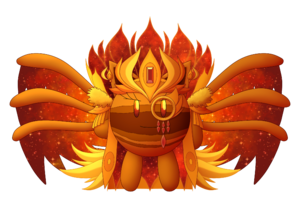
In total, the Glass Angels as an organization contained twelve seats, referred to as the First through Twelfth Angels. The First Angel was generally the most competent and powerful in combat, but the seats’ numbers otherwise had no bearing on their members’ actual strength. Glass Angels were picked at the discretion of the prime minister and the reigning monarch; not all seats had to be filled at any given time, meaning that some seats remained vacant for extended periods. Upon becoming a Glass Angel, the chosen individual automatically had the option to accept the title of rei and adopt the rei nobiliary particle.
In order from First Angel to Twelfth Angel, the last Glass Angels before Kerolon’s dissolution were Hanaweather rei Galaxon, Krydatio rei Rizoku, Trey Peterson, Centric Claude, Lukrezius rei Impollyn, Tessidris rei Mardukia, Nienna rei Cercani, Octantia, Alpymia rei Alcidora, Zyston Zeruelis, Yerden Yangtze, and Oscar Achebe.
The Kerolon Star Navy (KSN) functioned as the Kingdom's space force and was responsible for carrying out operations and combat in space. This included battling against rival forces, guarding already-acquired star systems, and exploring/colonizing newly-discovered ones. Due to the Kingdom's spacefaring nature, the Star Navy was the largest military division in the wider Kerolonian Armed Forces, with 2.15 billion members at its peak.
Originally a subdivision of Kerolon's conventional navy, the Star Navy eventually absorbed the conventional navy as technological advancement and interstellar expansion increasingly rendered oceanic combat obsolete. The Star Navy managed roughly 565,000 starships at its peak.
Starship classes
At its peak, Kerolon boasted a total of 47 starship classes, which are listed below. (TBA)
Corvettes
Destroyers
Frigates
Light Cruisers
Cruisers
Battle Cruisers
Carriers
World Breakers
Landing Cathedrals
Star Crushers
Grand Admirals and Orders

The Grand Admirals were the Star Navy's highest-ranking individuals, acting as the Kingdom's most powerful and intelligent starship commanders. The Grand Admirals often formed the forefront of interstellar colonization efforts and led massive starship fleet battles against opposing forces and civilizations. They also acted as competent temporary rulers, often overseeing recently conquered colonies during their first few years in order to quell any remaining dissent. As a whole, Kerolonian Grand Admirals were touted as the Kingdom's true greatest superweapons due to their exemplary use of clever tactics and strategies, which often proved sufficient to outwit even the most technologically powerful fleets and weapons.
Grand Admirals were rather rare; prior to the 12 Great Calamities, only 37 Grand Admirals existed amongst the Star Navy's billions of officers. Upon becoming Grand Admirals, individuals automatically earn the title of rei (but may decline to accept the rei nobiliary particle into their names) and are given the choice to join one of four orders, which originally formed as chivalric orders of knights during the First Age of Imperium. A secretive fifth order, the Apollyonic Foundation, also existed for those heavily invested in Izlondian technological artifacts, though its members rejected traditional Star Navy titles like "Grand Admiral" due to their order's focus on research and containment rather than space combat.
Each order was managed by a special Grand Admiral known as a Grandmaster Admiral, who also led the training of new Grand Admirals. Despite their leadership role, Grandmaster Admirals were not considered inherently superior to typical Grand Admirals, as their teaching roles included a responsibility to mold pupils into commanders superior to themselves. Because of this trait as well, Grandmaster Admirals were almost always much older than the rest of the members of the orders. An exception to this rule was the secret Order of Apollyon, which is led by a government-appointed individual called the Arbitrator instead.
Order of Sorellius
The Order of Sorellius was Kerolon's largest, oldest, and most powerful order, boasting 5,150 starships and 12.55 million members at its peak. It also had the highest amount of Grand Admirals during the 21st Century, with 12: Surrealia Serrette Sorellius, Polemos rei Goyette, Zephen rei Ostrov, Monarch rei Ryder, Sarvin rei Amarius, Slyton rei Marshall Christensen, Saru Lagrange, Syterion rei Doggett, Silisko rei Perone, Thriteria rei Nilsson, C. Octoria Hepta Hexia, and First Prince Jool Ponsolo Kerolon. Surrealia Serrette Sorellius acted as the Order's last Grandmaster Admiral.
Order of Kerbos
The Order of Kerbos was the Kerolonian Star Navy's second-largest order. At its peak, it held 5,000 starships and 12.35 million members.
Order of Novus
Order of Uris
Order of Apollyon
Economy
Culture and Society
Technology
At its peak, the Kingdom of Kerolon was one of the most technologically advanced societies of its era, with most researchers classifying it (and by extension, the Uingffhians as a whole) as on the higher end of a Kardashev Type I civilization.
In terms of destructive forces, Kerolon carried technology powerful enough to significantly alter stellar activity, potentially leading to the sterilization of entire star systems, though the Kingdom very rarely employed such weaponry. Smaller-scale weapons of mass destruction capable of decastating planets, continents, and smaller regions were also within Kerolon’s technological breadth.
Kerolon also boasted a variety of technological creations. Massive structures like orbital elevators, space colonies (e.g. O’Neill cylinders and Stanford toruses), and rudimentary partial dyson rings were all commonplace in the Kingdom’s star systems. Kerolon also boasted microscopic-level technology such as microscopic medical robots and genetic engineering technology.
MAJOR WIP




